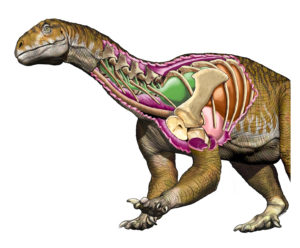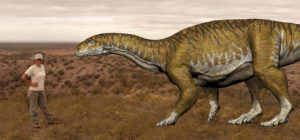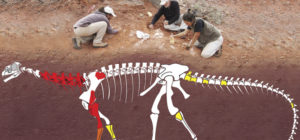Agencia CTyS-UNLaM
Scientists presented Ingentia prima, the first giant dinosaur that inhabited the Planet more than 200 million years ago. It exceeds three times the size of the largest Triassic dinosaurs known to date. The discovery was made at the Balde de Leyes deposit, southeast of the province of San Juan.
Dinosaurs were not always giants. The evolutionary history took millions of years for some species to double the weight of a current elephant and reach between eight and ten meters in length, but that time was much less than was believed: hence the great importance of the finding of Ingentia prima, which would have had a body mass of up to ten tons.
Dr. Cecilia Apaldetti, researcher at the Institute and Museum of Natural Sciences of the University of San Juan (IMCN) and CONICET, told the AgenciaCTyS-UNLaM that “this new species shows a strategy of growth unknown until now and indicates that the origin of gigantism came much earlier than previously thought”.
“Before this discovery, gigantism was considered to have emerged during the Jurassic period, approximately 180 million years ago, but Ingentia prima lived at the end of the Triassic, between 210 and 205 million years ago”, specified the study’s principal author which was published today in the prestigious journal Nature Ecology & Evolution.

Paleontologist Ricardo Martinez, co-author of the publication and also researcher at IMCN, commented, “the name of this new species, ‘Ingentia‘, refers to its colossal size, while ‘prima‘ indicates that it is the first known giant to today on the Planet”.
“Giant, above all, for his moment in evolution”, remarked Apaldetti. He added: “We see in Ingentia prima the origin of gigantism, the first steps so that, more than 100 million years later, sauropods of up to 70 tons could come into existence like those that lived in Patagonia”.
The largest quadruped and long-necked herbivorous dinosaurs of record, such as Patagotitan, Puertasaurus and Argentinosaurus, derived from the Triassic sauropodomorphs as Ingentia prima; what was not known, until now, is that gigantism had already developed more than 200 million years ago.
The researcher at the Institute of Research in Paleo biology and Geology of the National University of Río Negro (IIPG-CONICET, UNRN) Ignacio Cerda analyzed the bones of this new species to understand how it was growing in life: “Just as growth seasons can be observed in a tree, the bony cuts in Ingentia prima show that it had cyclical, seasonal growth, but what is striking is that the type of tissue that was deposited in the bones during these periods of growth is different from the other sauropods we knew so far. “
“This fabric allowed him to achieve a very rapid growth”, assumed Cerda. And he explained: “To differentiate the form of growth that it had, we can make an analogy with a car that goes at a continuous high speed, at 100 kilometers per hour, imagining that this is how the sauródopos grew, while Ingentia prima made a part of the trek to 300 kilometers per hour, during the seasons of growth, to stop later during the seasons of winter or shortage and, later, to grow back to 300 kilometers per hour “.
Cyclic growth was common among the primitive sauropodomorphs of the Triassic, but no other species exceeded three meters in length and three tons of body mass. “The difference is that the tissue formed in the rest of these sauropodomorphs did not have such a rapid deposition speed”, said Dr. Cerda, who also works at the Carlos Ameghino Provincial Museum in Cipolletti.
Although you can see these growth rings in the same way as trees, it is not possible to know the exact age at which this specimen died. “In this case, it is difficult to trace the continuity of the concentric lines, but we estimate that he was a subadult individual, who was still maturing, so he could have grown a little more”, commented the IIPG-CONICET researcher.

The first giant in the world already has a family
Beyond the fact that Ingentia prima, the first dinosaur to reach gigantism, was far from reaching the 70 tons that had the most giant sauropods of the late Cretaceous, the speed of bone tissue accumulation was not only superior to the species of its epoch, but also greater than that of the largest giants that inhabited Patagonia.
Dr. Diego Pol of the EgidioFeruglio Museum (MEF) and of CONICET, who was one of the authors of the study that presented the largest dinosaur of which one has knowledge -Patagotitan-, also participated in the analysis of Ingentia prima to determine its relations of kinship with other previously known species.
“What we demonstrate is the existence of a family that had not been recognized, of which Ingentia prima is a part, a species of South Africa and another of South America, which is further evidence of the close connection that existed between both continents at that time when everyone made up a supercontinent called Pangea”, Dr. Pol told to the Agencia CTyS-UNLaM.

The MEF researcher assuredthat “the discovery of this new species of the Triassic has a great implication for the evolutionary history, because it corresponds to the first stage of the dinosaurs and it is important to know that, at the moment they began to expand by the world, the first gigantic species have already appeared”.
“This finding gives a new look at the magnitude of the evolutionary explosion that the dinosaurs had”, said paleontologist Pol. He added: “This evolutionary explosion was so great that it explains the success the dinosaurs had during the rest of their era”.
Giantism is an evolutionary survival strategy, especially for herbivorous animals, because size is a form of defense against predators. “In order to achieve gigantism, Ingentia prima also had to adapt its physiology and develop an efficient food apparatus to be able to cover the energy requirement of an animal of that size,” specified Pol.
The director of the IMCNOscar Alcober stressed that this new species had another evolutionary feature that also would have favored its gigantism: “Cavities are observed in the bones of Ingentia, which lightened the weight of this species and would have favored it to acquire a larger size bodily”.
“These pneumatic cavities indicate that this new species had highly developed air sacs and a very efficient breathing system, similar to what happens in modern birds, which also helped it to keep its body cool despite its large size”, paleontologist Cecilia Apaldetti asserted.
Ingentia prima allows us to recognize that gigantism and diverse evolutionary patterns originated during the first stage of the emergence of dinosaurs. The Triassic period ended about 200 million years ago, at which time there was a great extinction, although the sauropods continued with their existence throughout the Jurassic and until the end of the Cretaceous, when they died, 65 million years ago, all species of non-avian dinosaurs.
An extraordinary site from the end of the Triassic
The researchers of the Institute and Museum of Natural Sciences of the University of San Juan have the privilege of having in their province the famous site of Ischigualasto, one of the most important of the Triassic world. As if this were not enough, a few years ago, they discovered the extraordinary location of the Bucket of Laws in the Marayes basin, with which they can complete the puzzle of the early days of the dinosaurs.
Dr. Ricardo Martinez told the AgenciaCTyS-UNLaM that “Bucket of Laws is a new site with a whole unknown fauna until now, while in Ischigualasto we have a succession of Triassic rocks between 250 and 213 million years old, in this new site we have from the 235 million years until the end of the Triassic and, even, the first stage of the Jurassic Period”.
In Balde de Leyes, in addition to discovering the giant herbivore Ingentia prima, they have also found and named the carnivore Lucianovenatorbonoi. “Lucianovenator and Ingentia are from the same period”, said Martínez. And he analyzed: “Although Lucianavenator was not very big, because it measured a meter and a half, it was a bug of care and could have fed on Ingentia, perhaps making a group attack or taking advantage of any of this giants was injured or in old age”.
“However, we have also found teeth that belong to a carnivore with a skull of between 60 and 80 centimeters, so we know that there was a larger predator circling there and that it could have been a theropod or some predecessor of the crocodiles “, added the researcher.
With each new campaign, more species and groups continue to appear. Regarding what the environment was like at that time, Martínezsaid: “The temperature was higher and the weather varied a lot between the seasons; meanwhile, although we have not found fossil remains of the flora in the Balde de Leyes, we know that if Ingentia, a large herbivore, lived there had to be enough vegetation to feed it”.
The site was a kind of savanna at the end of the Triassic. In addition to the dinosaurs that were discovered, there were also giant iguanas, turtles, and species with a shape similar to mice, which could be linked to the origin of mammals.
However, as the end of the Triassic approached, the environment became more arid, which ended up causing a series of extinctions that culminated 200 million years ago, after which new species would emerge in the Jurassic period. All this information has been preserved in the rocks of the new site and will be revealed in future campaigns and research. (The news is unedited version received from Agencia CTyS-UNLaM)

